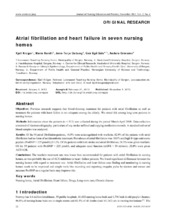| dc.contributor.author | Krüger, Kjell | en_US |
| dc.contributor.author | Sandli, Marie | en_US |
| dc.contributor.author | Geitung, Jonn Terje | en_US |
| dc.contributor.author | Eide, Geir Egil | en_US |
| dc.contributor.author | Grimsmo, Anders | en_US |
| dc.date.accessioned | 2013-08-23T12:49:46Z | |
| dc.date.available | 2013-08-23T12:49:46Z | |
| dc.date.issued | 2012-11-01 | eng |
| dc.Published | Journal of Nursing Education and Practice 2(4): 22-32 | eng |
| dc.identifier.issn | 1925-4040 | |
| dc.identifier.issn | 1925-4059 | |
| dc.identifier.uri | https://hdl.handle.net/1956/6988 | |
| dc.description.abstract | Objectives: Previous research suggests that blood-thinning treatment for patients with atrial fibrillation as well as treatment for patients with heart failure is not adequate among the elderly. We tested this among long-term patients in nursing homes. Methods: Information about the patients (n = 513) was collected during the period March-April 2008. Data collection consisted of electrocardiography, particulars of any stroke suffered and copying medication records. A standardized set of blood samples was analyzed. Results: Of the 91 atrial fibrillation patients, 14.3% were anticoagulated with warfarin. 42.0% of the patients with atrial fibrillation had no form of antithrombotic treatment. Prevalence of atrial fibrillation was 18.8% and high B-type natriuretic peptide (ProBNP > 225 pmol/L) 13.2%. Of the patients with both stroke and atrial fibrillation, 24.3% were given warfarin. Of the 59 patients with ProBNP > 225 pmol/L and adequate renal function (eGFR > 50 ml/min), 22.0% were given ACE/A2B. Conclusions: The warfarin treatment rate was lower than recommended for patients with atrial fibrillation in nursing homes, as was probably the use of ACE-inhibitors to heart -failure patients. We found significant differences between the nursing homes with regard to treatment rate. Atrial fibrillation and heart failure case finding and monitoring in nursing homes needs to be improved and simple tools like recording and reporting irregular pulse by doctors and nurses and measure ProBNP on a regular basis may improve this. | en_US |
| dc.language.iso | eng | eng |
| dc.publisher | Sciedu Press | eng |
| dc.relation.ispartof | <a href="http://hdl.handle.net/1956/6992" target="blank">Can a structured electronic medical record with decision-making support improve nursing home quality?</a> | eng |
| dc.rights | Attribution CC BY | eng |
| dc.rights.uri | http://creativecommons.org/licenses/by/3.0/ | eng |
| dc.subject | Nursing homes | eng |
| dc.subject | Atrial fibrillation | eng |
| dc.subject | Heart failure | eng |
| dc.subject | Drugs | eng |
| dc.subject | Long-term care | eng |
| dc.subject | Chronic disease | eng |
| dc.title | Atrial fibrillation and heart failure in seven nursing homes | en_US |
| dc.type | Peer reviewed | |
| dc.type | Journal article | |
| dc.description.version | publishedVersion | en_US |
| dc.identifier.doi | https://doi.org/10.5430/jnep.v2n4p22 | |
| dc.identifier.cristin | 1006874 | |
| dc.source.journal | Journal of Nursing Education and Practice | |
| dc.source.40 | 2 | |
| dc.source.14 | 4 | |
| dc.source.pagenumber | 22-32 | |

